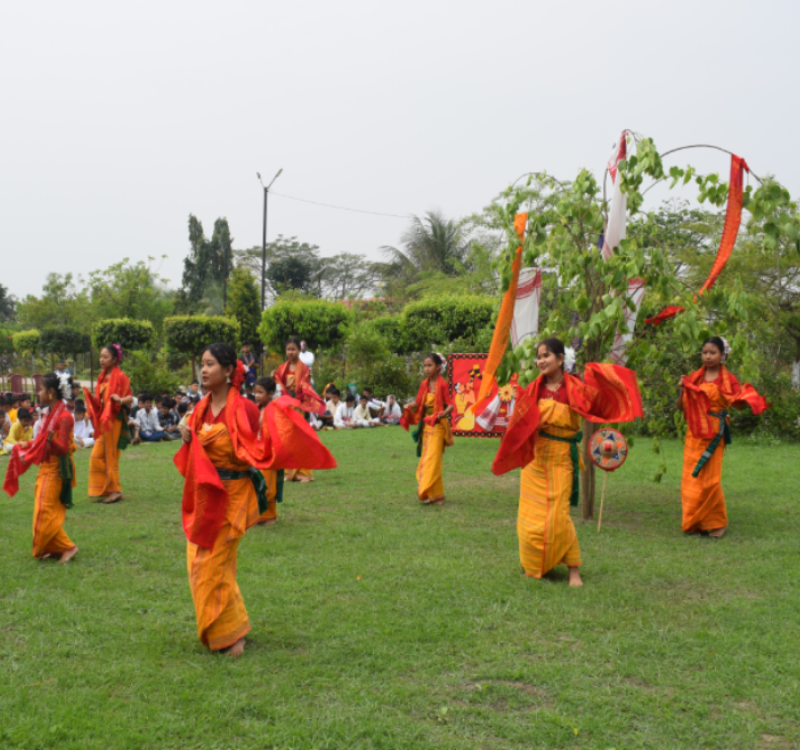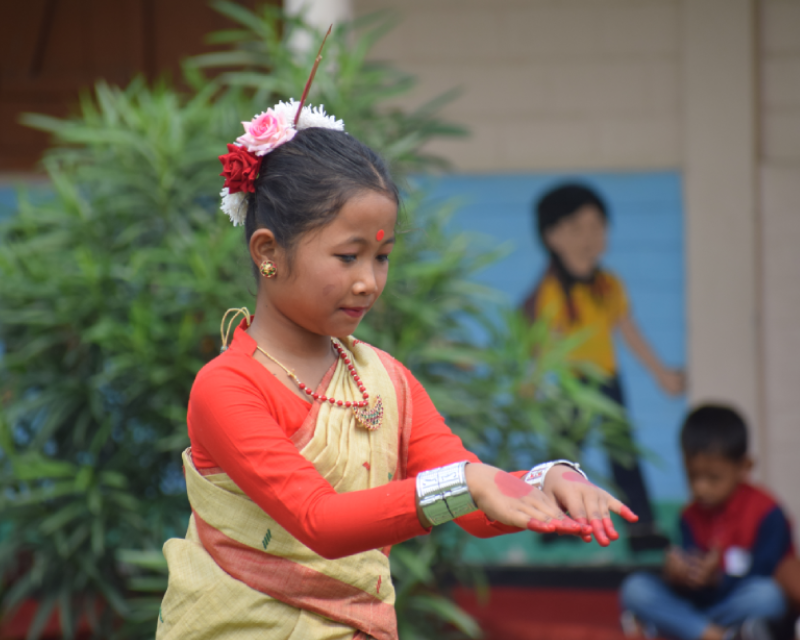RONGJALI BWISAGU / RONGALI BIHU
Rongjali Bwisagu and Rongali Bihu are two vibrant cultural festivals celebrated with much enthusiasm in the northeastern state of Assam, India. While both festivals are rooted in Assamese culture and share similarities, they also have distinct characteristics and significance.

RONGJALI BWISAGU
Rongjali Bwisagu, also known as Bihu in the Bodo community, is a colorful festival celebrated by the Bodo tribe, one of the largest indigenous communities in Assam. It marks the beginning of the new year and the spring season, typically falling in mid-April. The festival is a celebration of life, fertility, and the abundance of nature.
Key features:
- Cultural Performances: Rongjali Bwisagu is marked by traditional dance performances, including the vibrant Bwisagu dance, where men and women dressed in traditional attire dance to the rhythm of drums and bamboo flutes.
- Music and Singing: Traditional Bodo songs, known as Bwisagu songs, are sung during the festival, reflecting the community's joy and gratitude for nature's blessings.
- Traditional Attire: People adorn themselves in traditional Bodo attire, with women wearing dokhna (a traditional scarf) and aronai (a traditional skirt), and men wearing dhoti and chadar.
- Feasting: The festival is incomplete without delicious Bodo cuisine, including dishes like rice cakes and a variety of traditional Dress (Bwisagu)
Dress (Bwisagu)
Bodo Bwisagu attire is a traditional costume worn by the Bodo community during the Bwisagu festival, which is one of the most significant festivals celebrated by the Bodo people of Assam, India. The festival usually falls in mid-April and marks the beginning of the new year according to the Bodo calendar. The Bodo community, known for their rich cultural heritage, celebrates Bwisagu with great enthusiasm and traditional fervor.
The attire worn during the Bwisagu festival is colorful and vibrant, reflecting the cultural identity and traditions of the Bodo people. Here's a description of the typical Bodo Bwisagu attire:

- Arnapat: Arnapat is the traditional attire worn by Bodo women during Bwisagu. It consists of a vibrant and colorful Mekhela, which is a two-piece garment. The lower part, called the Rikong, is wrapped around the waist and pleated, while the upper part, known as the Risa, is draped over the upper body like a saree. The Mekhela is usually made of rich silk fabric with intricate traditional designs and motifs.
- Jwmgra (Blouse): The blouse worn with the Mekhela is called Jwmgra. It is typically adorned with exquisite embroidery, beadwork, or mirror work, adding to the beauty of the attire. The blouse comes in various colors and patterns, complementing the overall look of the Arnapat.
- Traditional Jewelry: Traditional Jewelry: Bodo women adorn themselves with traditional jewelry during Bwisagu, which includes necklaces, earrings, bangles, and anklets. The jewelry is often made of silver or gold and is intricately designed with floral or geometric patterns. These ornaments add elegance and grace to the overall attire.
RONGALI BIHU
Rongali Bihu, also known as Bohag Bihu, is the most popular and widely celebrated festival in Assam. It marks the Assamese New Year and coincides with the advent of spring, usually celebrated in mid-April. Rongali Bihu is a time of joy, renewal, and community bonding.

Key features:
Traditional Dance: The Bihu dance is the highlight of Rongali Bihu celebrations, where both men and women perform intricate dance steps to the rhythmic beats of the dhol (drum) and pepa (traditional flute).
Music and Singing: Traditional Bihu songs, called Bihugeet, are sung during the festival, expressing themes of love, nature, and cultural pride.
Traditional Attire: People adorn themselves in traditional Bodo attire, with women wearing dokhna (a traditional scarf) and aronai (a traditional skirt), and men wearing dhoti and chadar.
Traditional Attire: Assamese people dress in their traditional finery during Rongali Bihu, with women wearing mekhela chador (a two-piece garment) and men wearing gamosa (a traditional cloth) and dhoti.
Feasting: : Like Rongjali Bwisagu, Rongali Bihu is also a time for feasting and indulging in traditional Assamese delicacies, such as pitha (rice cakes), laru (sweet balls).
While Rongjali Bwisagu and Rongali Bihu have their unique customs and rituals, both festivals share common themes of celebrating nature, fostering community spirit, and ushering in prosperity and happiness for the coming year. These festivals not only hold immense cultural significance but also serve as occasions for strengthening familial and social bonds among the people of Assam.
- Gamosa: Gamosa is a traditional Assamese towel that holds significant cultural importance. During Bwisagu, both men and women may carry a Gamosa, draped over their shoulders or tied around their waist, as a symbol of respect and hospitality
- Men's Attire: Bodo men also dress in traditional attire during Bwisagu, which typically includes a dhoti or lungi paired with a shirt or kurta. They may also wear traditional headgear like the Jwmgra Mwchakra, a colorful turban adorned with feathers or decorative elements.
Overall, the Bodo Bwisagu attire reflects the rich cultural heritage and traditions of the Bodo community. It embodies the spirit of joy, celebration, and unity, bringing people together to rejoice in the festivities and usher in the new year with hope and happiness.
Dress (BIHU)
Bihu, the vibrant and joyous festival celebrated in the Indian state of Assam, is not just about lively dances and melodious tunes; it's also about embracing cultural traditions, including attire. The Bihu attire reflects the rich cultural heritage of Assam and plays a significant role in the festivities.

Mekhela Chador: This is the traditional attire worn by Assamese women during Bihu and other festive occasions. The Mekhela Chador comprises two pieces of cloth - the Mekhela, which is the lower garment, and the Chador, which is the upper garment. The Mekhela is draped around the lower body, while the Chador is worn as an elegant wrap over the upper body. These garments are usually made of silk, showcasing intricate designs and vibrant colors. During Bihu, women often choose bright and cheerful hues like red, yellow, green, or blue, adorned with traditional motifs like the jaapi (traditional Assamese hat), flowers, or geometric patterns.
Gamosa: The Gamosa is an integral part of Assamese culture and attire, and it holds immense significance during Bihu celebrations. It is a traditional Assamese towel, usually made of cotton or silk, adorned with intricate designs and patterns. The Gamosa is draped around the neck or carried over the shoulder, symbolizing respect, honor, and hospitality. During Bihu, people often use the Gamosa as an accessory to complement their attire, adding an extra touch of tradition and elegance to their look.
Muga Silk: Muga silk, also known as the golden silk of Assam, holds a special place in Assamese culture and is highly prized for its lustrous texture and durability. During Bihu, both men and women may choose to wear attire made of Muga silk, such as Mekhela Chadors, Kurta-Pajamas, or traditional Assamese outfits like the Sador-Mekhela for women and the Dhoti-Kurta or Gamosa for men. The golden sheen of Muga silk adds a regal and luxurious touch to Bihu attire, making it perfect for the festive celebrations.
Traditional Jewelry: Completing the Bihu attire are traditional Assamese jewelry pieces, which add charm and elegance to the overall look. Women may accessorize their Mekhela Chadors with intricately designed earrings, necklaces, bangles, and anklets made of gold, silver, or other metals, adorned with precious stones and beads. These jewelry pieces often feature motifs inspired by Assamese culture and nature, such as flowers, birds, and animals, adding a touch of tradition and symbolism to the festive ensemble.
Men's Attire: While women predominantly wear Mekhela Chadors during Bihu, men opt for traditional Assamese outfits like the Dhoti-Kurta or the Assamese-style shirt and trousers. These garments are usually made of cotton or silk and are available in a wide range of colors and designs. Men may also accessorize their attire with a Gamosa draped over the shoulder or tucked into the waistband, along with traditional jewelry like earrings or necklaces, depending on personal preference and cultural norms.
In essence, Bihu attire embodies the cultural richness and vibrancy of Assam, with its colorful fabrics, intricate designs, and traditional motifs. Whether it's the elegant Mekhela Chador, the symbolic Gamosa, or the luxurious Muga silk garments, each element of Bihu attire reflects the spirit of celebration and the enduring traditions of Assamese culture.
